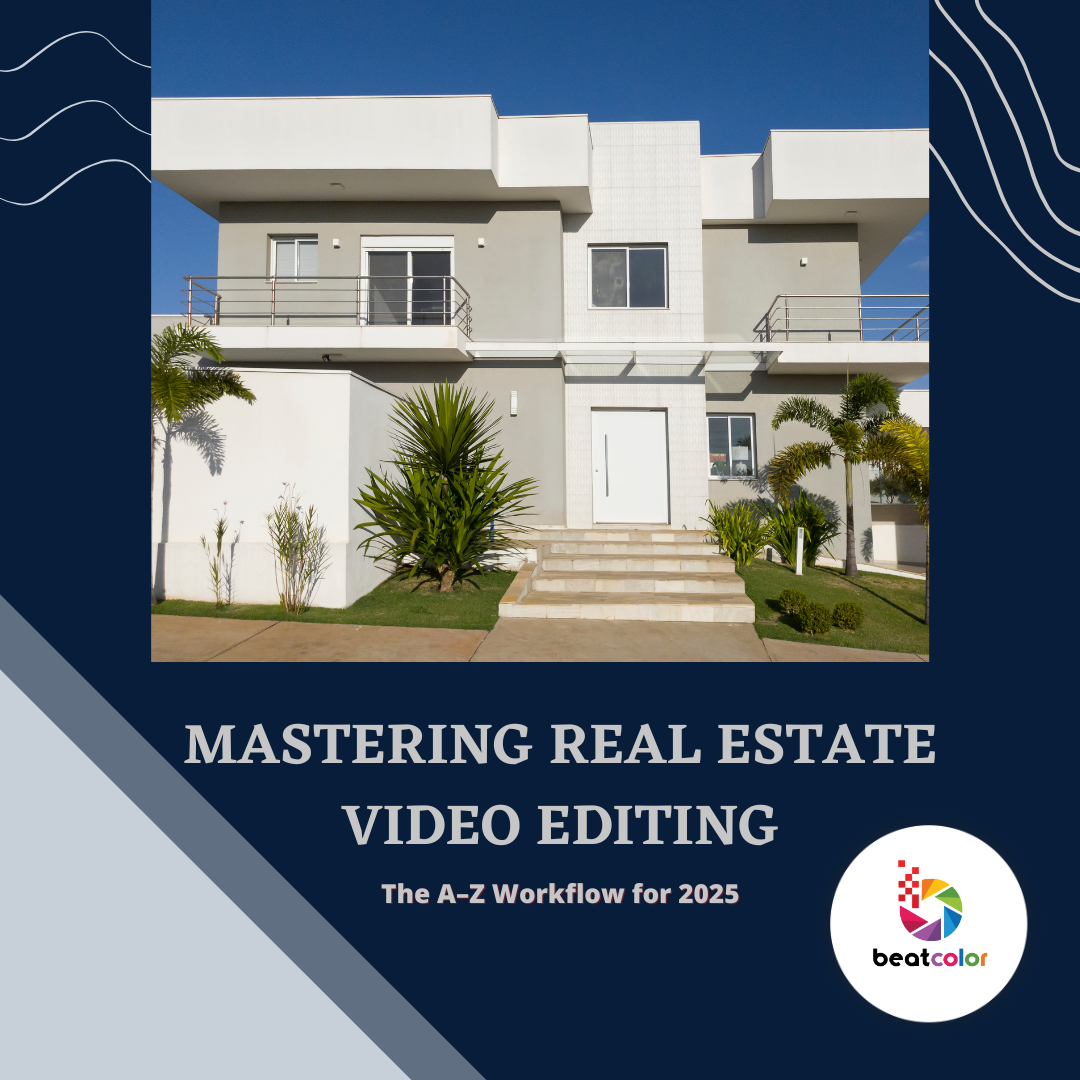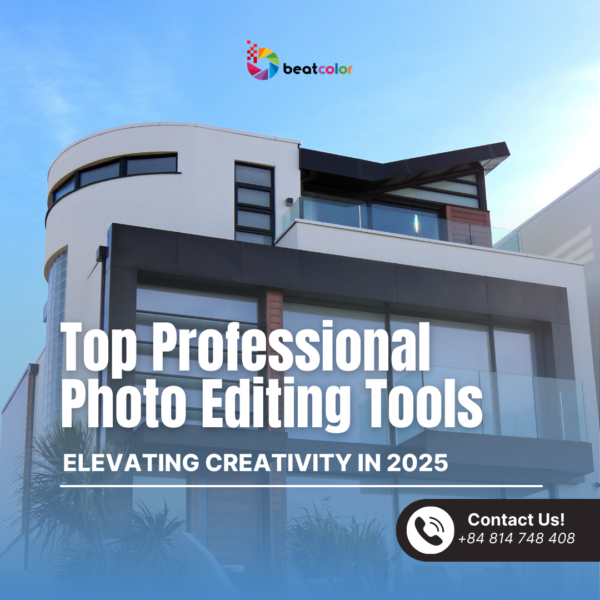Mastering Real Estate Video Editing: The A–Z Workflow for 2025
Real estate video editing has become a core marketing tool in today’s property industry. Buyers now expect polished videos that show each room clearly. They also want smooth flow and bright visuals. As a result, the editing process matters more than ever. This guide breaks down the entire workflow and includes the latest 2024 and 2025 updates.
Why Real Estate Video Editing Matters Today
Real estate video editing continues to gain importance because buyers want fast information. Recent surveys from 2024 showed that 84% of buyers prefer video tours. Moreover, property videos on listing sites increase engagement by nearly 60%. Therefore, agents and editors must produce videos that capture attention quickly. Good editing creates trust, boosts clarity, and strengthens a listing’s appeal.
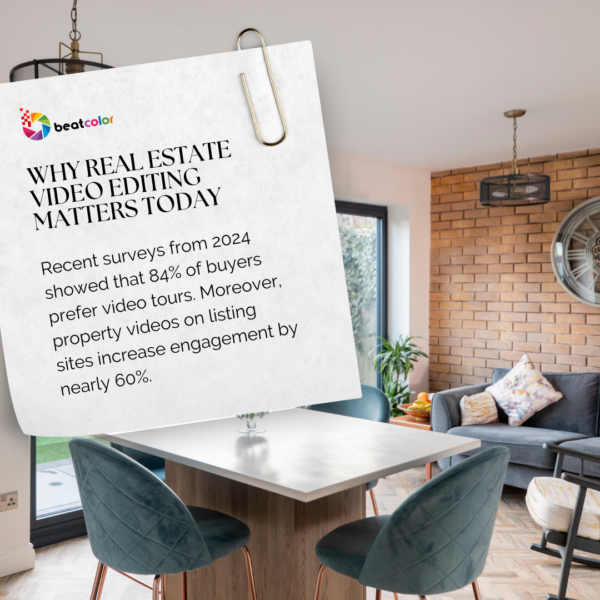
Start With a Clear Plan
Every strong video starts with a plan. Editors must know the property type, location, and key features. Planning helps create a smooth structure for the final video. It also prevents wasted time. A clear plan improves story flow and helps highlight the best angles. Additionally, it keeps the editing consistent with the agent’s vision.
Organize Footage Before Editing
Well-organized footage saves hours of work. Therefore, editors should label each clip by room and angle. Drone clips need separate folders. Interior footage and exterior footage also require different organization. This step reduces mistakes and speeds up revisions. Better organization also strengthens communication between agents and editors.
Select the Right Editing Software for Real Estate Video Editing
Editors now have access to many powerful tools. Adobe Premiere Pro remains a top choice. Final Cut Pro also offers great speed for Mac users. However, DaVinci Resolve grew rapidly in 2024 because of its advanced color tools. It also includes strong free features. Furthermore, new AI editing platforms appeared in late 2024. These tools help detect scenes, remove noise, and stabilize shaky shots automatically. As a result, editors complete projects faster without losing quality.
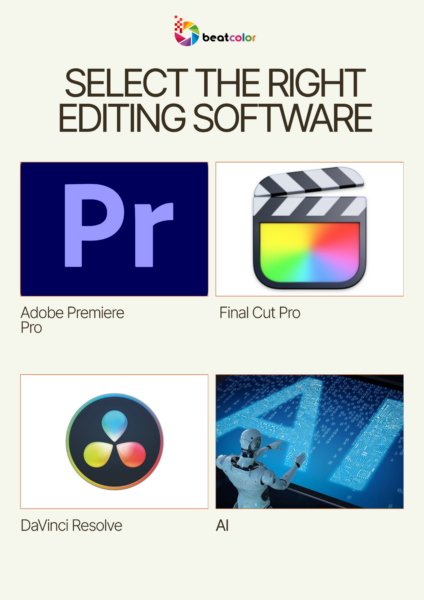
Build a Clean Timeline Structure
A clean timeline keeps the video easy to follow. Editors should place the most attractive clips at the beginning. This approach holds attention during the first few seconds. Next, the video should move in a natural walkthrough order. For example, it can start with the entrance and continue through each room. A strong structure helps buyers feel immersed in the space. Additionally, it ensures the video moves at a comfortable pace.
Real Estate Video Editing: Correct Shaky Footage and Camera Issues
Shaky clips distract buyers. Therefore, stabilization must be part of the process. New tools released in 2024 reduce warping and create smoother movement. Editors should use careful settings to avoid distortion. Lens correction also plays a key role. Wide-angle lenses often bend walls and furniture. However, modern tools fix distortion accurately. This correction creates a more trustworthy presentation.
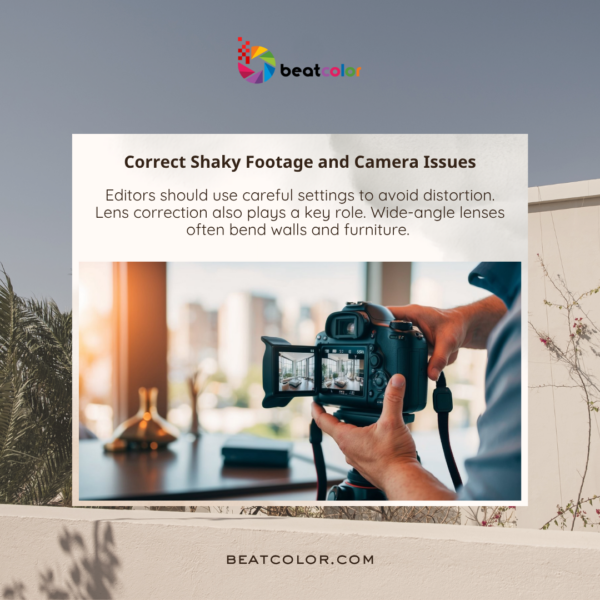
Focus on Color and Exposure
Color grading sets the tone for the entire video. Real estate video editing requires bright, natural, and consistent colors. Editors should balance shadows, mid-tones, and highlights. White balance must stay neutral to show true colors. New AI-assisted color tools launched in 2024 help match tones across all clips. Moreover, editors can use masks to remove glare or brighten dark corners. Good color grading increases property appeal and improves viewer trust.
Add Subtle Motion for Real Estate Video Editing
Motion guides viewer attention and strengthens the story. However, real estate videos must avoid heavy effects. Instead, editors should use gentle pans, slight zooms, and soft transitions. These moves create a calm and natural feel. They also help maintain visual continuity. Smooth motion gives buyers a pleasant viewing experience.
Keep Text Clean and Useful
Text overlays can enhance the video when used correctly. Editors should add only essential information. For example, they can highlight the property size or location. Furthermore, simple fonts keep the video clean. Modern real estate videos favor minimal and modern typography. Text should never cover important details. It should support the visuals, not compete with them.
Mix Audio for a Better Experience
Audio influences how buyers feel when watching the video. Therefore, editors must pick music that matches the property. Quiet and elegant music suits luxury homes. Light and upbeat tracks work well for modern spaces. Editors should also balance audio levels. Sudden volume changes push viewers away. Additionally, natural sound effects can improve immersion when used sparingly.
Use AI Tools for Real Estate Video Editing
AI technology grew rapidly across 2024 and early 2025. Editors now use AI to stabilize footage, remove noise, and match colors. They also use AI to create short social media clips. These short videos attract younger buyers and increase listing visibility. Furthermore, AI tools suggest edits that improve pacing. Although AI helps, editors still need creative control to maintain a natural look.
Export Settings for Real Estate Videos
Correct export settings shape the final quality. Listing videos should be exported in 4K when possible. Higher resolution increases credibility and sharpness. However, editors should also prepare 1080p versions for mobile platforms. The H.264 format remains the most widely used codec because it keeps file sizes small. Additionally, the bitrate should stay high enough to avoid pixelation.

Deliver Files Smoothly
Agents prefer simple file access. Therefore, editors often use cloud tools like Dropbox or Frame.io. These platforms make feedback easy. They also store files securely for long-term use. Clear labeling helps clients find the correct versions quickly.
Review Each Project for Improvements
Growth comes from consistent review. Editors should check every finished project. They can study pacing, color, and clarity. They should also gather feedback from agents. This practice helps strengthen future results. Continuous improvement ensures long-term success in the competitive real estate market.
Final Thoughts
Real estate video editing continues to evolve with new tools, trends, and buyer expectations. Editors must balance clarity, creativity, and accuracy to produce strong results. They also need efficient workflows to meet fast market deadlines. When each step works smoothly, the final video tells a compelling story that helps properties stand out. Strong editing improves engagement, builds trust, and supports successful sales. With the right techniques, editors can deliver high-quality videos that meet modern standards and attract today’s demanding buyers.
Read more:
Luxury Virtual Staging: Redefining Modern Property Marketing
High-End Photo Retouching Services in Winter
A Real Estate Photo Editing Company That Changes How Homes Sell


